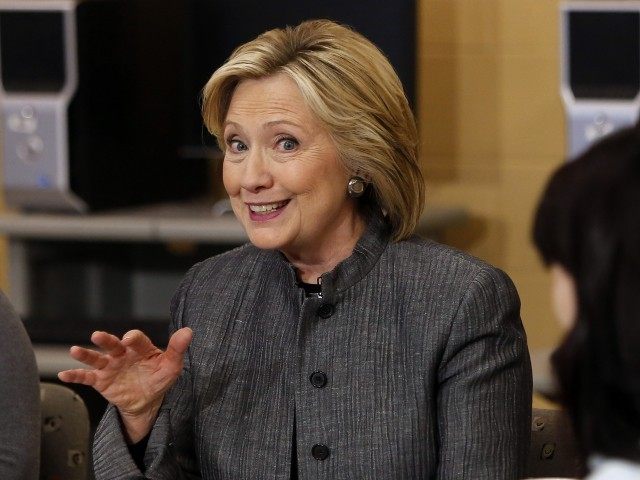This week, the New York Times released a poll conducted with CBS News. It frames the results as positive for Democratic Presidential candidate Hillary Clinton. However, a closer look at the polling numbers shows that the Times’ positive spin for Clinton does not hold up.
“Hillary Clinton’s Appeal Survives Scrutiny, Poll Says,” reads the headline on a Times article that goes on to claim, “Americans now view Mrs. Clinton more favorably and more see her as a strong leader than they did earlier in the year, despite weeks of scrutiny about her ethics, a New York Times/CBS News poll has found.”
The main proof offered that Clinton has “survived scrutiny” is that, compared to an earlier poll, the percentage of respondents with an unfavorable opinion of her decreased from 37 percent to 36 percent, and her favorable numbers went from 26 percent to 35 percent.
The Times does acknowledge that Clinton’s numbers are lower than they were when she last launched a presidential campaign (July 2007), but leaves it to the reader to carefully parse through hundreds of lines from the polling data to see how far she has fallen.
Looking at the specific question of Clinton’s favorability ratings, she was viewed favorably by somewhere in the low 40s to high 30s for much of her last campaign. After dropping out of the primary and supporting Barack Obama, she hit 45 percent favorability in the fall of 2008, and scored in the mid- to high-50s during her tenure as Secretary of State.
It should also be noted that during the polls conducted from 2007 through 2013, only a single digit percentage of respondents said they did not know enough about Clinton to answer the question. In contrast, the percentage of respondents answering that they did not know was 11 percent for this most recent poll, and 17 percent for the previous one.
The poll was conducted by telephone, to landline and cell phone numbers nationwide, from April 30 to May 3, 2015. The polling sample was 1,o27 adults, of whom 868 were registered to vote. The margin of error for the entire sample was +/- 3 percent.
According to Nate Silver, the Editor in Chief of FiveThirtyEight, “polls of all registered voters or all adults usually overstate the performance of Democratic candidates.” Silver analyzed polls during presidential years from 1992 through 2012 and found that there was an average Democratic bias of 1.1 percent and a median Democratic bias of 2 percent, and that was taking into account the widespread Republican bias that was a problem in the 2012 polling.
Thus, the Times‘ decision to have a significant portion of its sample not registered to vote at all — potentially not even legally eligible to vote — casts some additional doubt on the results. Some questions were only asked of registered voters, but this crucial favorable/unfavorable question was posed to the entire sample.
The poll numbers also show what seems to be an oversampling of Democrats, and potential increase in that oversampling even since their last poll. The poll indicates that 23 percent of respondents were Republicans, 33 percent were Democrats, 39 percent Independents, and 6 percent did not know or did not answer. The Times‘ previous poll, conducted December 4 – 7, 2014, included 23 percent Republicans, 32 percent Democrats, 35 percent Independents, and 10 percent did not know or did not answer.
With a margin of error of +/-3 percent, and what appears to be a systemic oversampling of Democrats, the interpretation by the Times of this poll is not as clear cut as their sunny headline would convey.
Moreover, the critical problem for Clinton is that she is still underwater, with more people viewing her unfavorably than favorably, and while she remains the frontrunner in the Democratic primary, she has a much steeper climb to win over Independents, and Republicans are downright hostile to her. A number of other answers in the poll reveal major vulnerabilities for Clinton.
Forty-two percent of Independents would not consider voting for her at all. Among all poll respondents, 39 percent do not think she “shares the values most Americans try to live by,” 45 percent think she is “not honest and trustworthy.”
Thirty-one percent do not think she has “strong qualities of leadership,” a troubling number for someone who was supposed to be a major leader in American foreign policy and diplomacy as Secretary of State. Regarding her work as Secretary of State, 38 percent disapproved of how she did that job, the worst result for her going back to 2008.
Thirty-three percent think it would be a bad thing for another Bush or Clinton to be in the White House, and 61 percent believe Clinton, if elected President, would continue Obama’s policies — not a helpful figure for Clinton considering Obama’s own popularity problems.
Follow Sarah Rumpf on Twitter @rumpfshaker.

COMMENTS
Please let us know if you're having issues with commenting.